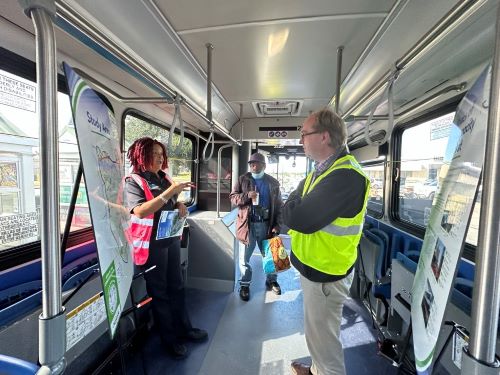Here’s How High-Capacity Transit Can Connect the City of Chesapeake
The City of Chesapeake defines itself as an exceptional place to live, learn, work, farm, and play. As it continues to attract more residents, students, and businesses, a looming question has become, how can high-capacity transit best support this anticipated growth?
What is Connecting Chesapeake?
Hampton Roads Transit and the City of Chesapeake are collaborating to explore high-capacity transit options that will enhance the economy, align with future growth plans, and improve connectivity to the regional transportation network.
HRT decided to ask people who live, work, shop, travel, attend school or receive healthcare services in and/or near the City of Chesapeake for their thoughts on high-capacity transit. Nearly 1,200 people completed a short, online convenience survey, sharing their degree of support and perceived benefits to the community.

Positive Support for High-Capacity Transit
About 73% of respondents support high-capacity transit and think it could benefit the community by reducing congestion, increasing connectivity, and offering a convenient alternative to automobiles. Reduced reliance on cars means more inclusive, forward-thinking transit options. High-capacity transit can also reduce travel times, leaving more time for leisure, work, or other activities, and providing more opportunities to visit places previously out of reach.
More than half of all respondents say they are likely to use high-capacity transit, to commute to work or travel for leisure. High-quality, accessible, and reliable service are attractive features to potential riders.
Open-ended responses to the survey were overwhelmingly positive and supported the statistical data we received from residents, workers, and frequent visitors who view better transit options as a necessary improvement, beneficial for the wider community, and a step towards a more connected future for the region. Many residents and visitors emphasized the need for high-capacity transit to be excellent quality, highly reliable, fast, and efficient, otherwise people will not use it.
While most open-ended responses expressed support, a few voiced oppositions, citing the financial/tax burden on residents, overdevelopment that could impact the rural quality of life, desire for other projects to get priority, and concerns around safety and crime.
Moving Forward: Public Engagement and More
As the study moves forward, HRT will continue working with the City of Chesapeake as it develops its long-term Greenbrier Area Plan and overall Comprehensive Plan Update. HRT will continue collaborating with the City, residents, businesses, and community partners to explore the many advantages of tying transit planning to land use planning. From knitting communities together, to reducing congestion, to increasing mobility options, to ensuring fair access for everyone.
HRT and the City have been working hard on this study for nearly one year, engaging and educating the community during each step. In April, HRT will be sharing information on the study, including transit route alternatives to be screened and evaluated based on community feedback. You can learn more about these upcoming community events, including a Facebook livestream, on the project website.





